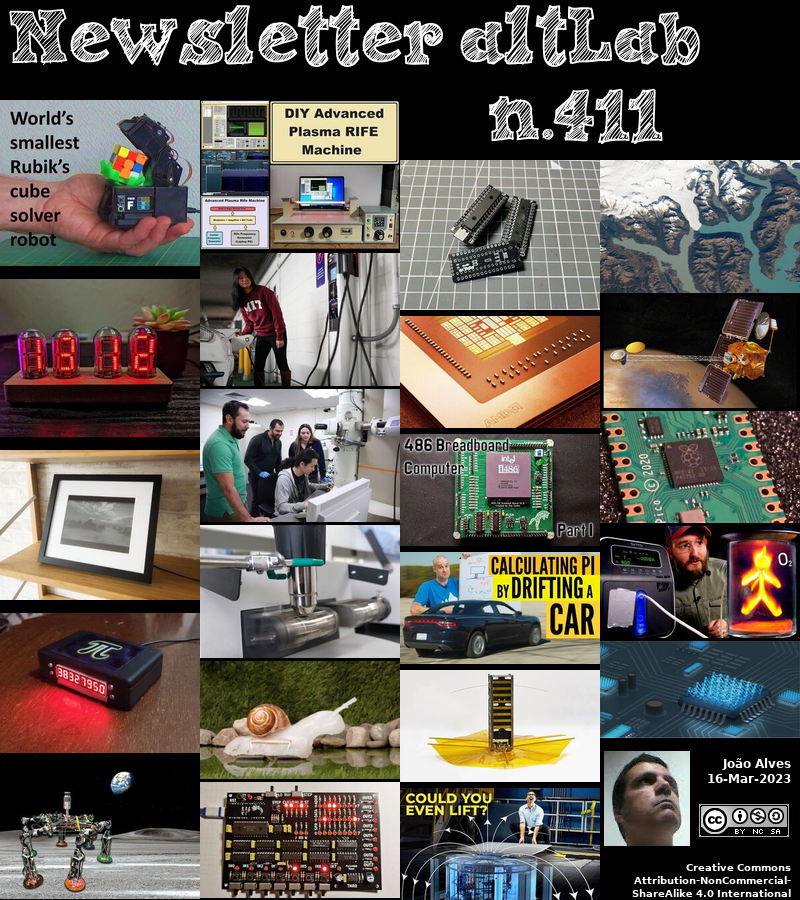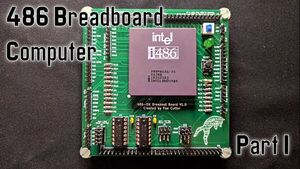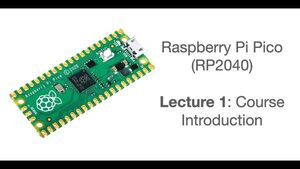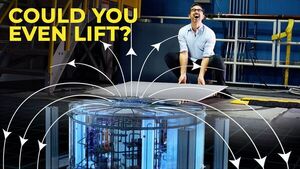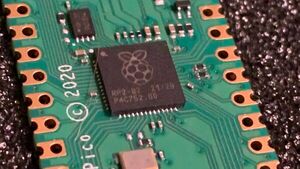2023-03-16 - Nº 411
Editorial
Esta é a Newsletter Nº 411 que se apresenta com o mesmo formato que as anteriores. Se gostar da Newsletter partilhe-a!
Todas as Newsletters encontram-se indexadas no link.
Esta Newsletter tem os seguintes tópicos:
Faz hoje anos que nascia, em 1789, o físico alemão Georg Ohm. Ele mostrou por experiência (1825) que não existem condutores eléctricos "perfeitos". Todos os condutores têm alguma resistência. Ele declarou a famosa lei de Ohm (1826), agora escrita como: "Se a dada temperatura permanecer constante, a corrente que flui através de certos condutores é proporcional à diferença potencial (voltagem) através dela" ou V=iR.
Faz também hoje anos que nascia, em 1821, o matemático alemão Eduard Heine. Ele é responsável por contribuições sobre equações diferenciais parciais, a teoria do calor, soma de séries, fracções contínuas e funções elípticas. Heine também trabalhou em polinómios de Legendre, funções de Lamé e funções de Bessel. Ele continua conhecido pelo teorema de Heine-Borel, que pode ser dado de uma forma simplificada como "um subconjunto dos reais é compacto se e só se for fechado e delimitado". Heine formulou também o conceito de continuidade uniforme.
Faz igualmente hoje anos que nascia, em 1836, o engenheiro e inventor anglo-americano Andrew Smith Hallidie. Ele construiu o sistema de teleférico utilizado pela primeira vez nas íngremes colinas das ruas de São Francisco (1 de Agosto de 1873). Os bondes sobre carris foram equipados com um dispositivo mecânico que agarrava um cabo em movimento sem fim subterrâneo para viajar e soltava para parar. O cabo passava ao redor de roldanas e era conduzido por uma grande roda numa casa de máquinas. Tinha aprendido o negócio de fazer cabos de arame com o seu pai antes de se mudar para os EUA (1853), onde concebeu e construiu pontes e calhas suspensas de arame. Começou a fabricar corda de arame em 1857. Hallidie também desenvolveu um método de movimentação de carga sobre desfiladeiros usando um cabo de aço sem fim, e invenções para a transmissão de energia com cabo de aço, o que semeou a sua ideia para os teleféricos.
Faz também hoje anos que nascia, em 1846, o matemático sueco Magnus Gösta Mittag-Leffler. Ele fundou a revista internacional de matemática Acta Mathematica e cujas contribuições para a investigação matemática ajudaram a fazer avançar a escola escandinava de matemática. Mittag-Leffler fez numerosas contribuições para a análise matemática (preocupada com limites e incluindo cálculo, geometria analítica e teoria da probabilidade). Trabalhou na teoria geral das funções, relativa às relações entre variáveis independentes e dependentes. O seu trabalho mais conhecido dizia respeito à representação analítica de uma função de valor único, este trabalho culminou no teorema de Mittag-Leffler.
Faz igualmente hoje anos que nascia, em 1853, o físico alemão Heinrich Kayser. Ele descobriu a presença de hélio na atmosfera da Terra. Antes disso, os cientistas tinham detectado hélio apenas no sol e em alguns minerais. O primeiro trabalho de investigação de Kayser foi sobre as propriedades do som. Em colaboração com o físico e matemático Carl D.T. Runge, Kayser mapeou cuidadosamente os espectros de um grande número de elementos. Ele escreveu um manual de espectroscopia (1901-12) e um tratado sobre a teoria dos electrões (1905).
Faz também hoje anos que nascia, em 1915, o matemático japonês Kunihiko Kodaira. Ele recebeu a Medalha Fields em 1954 pelo seu trabalho em geometria algébrica e análise complexa. O trabalho de Kodaira inclui aplicações dos métodos espaciais de Hilbert a equações diferenciais que foi um tópico importante no seu trabalho inicial e foi em grande parte o resultado da influência de Weyl. Através da influência de Hodge, ele também trabalhou em integrais harmónicos e mais tarde aplicou este trabalho a problemas em geometria algébrica. Outra área importante do trabalho de Kodaira foi a aplicação de roldanas à geometria algébrica. Por volta de 1960, envolveu-se na classificação de espaços analíticos compactos e complexos. Um dos temas que percorre grande parte do seu trabalho é o teorema de Riemann-Roch. Ganhou o Prémio Wolf de 1985.
Faz igualmente hoje anos que nascia, em 1918, o físico americano Frederick Reines. Ele recebeu o Prémio Nobel da Física de 1995 pela sua detecção em 1956 de neutrinos, trabalhando com o seu colega Clyde L. Cowan, Jr. O neutrino é uma partícula subatómica, um pequeno leptão com pouca ou nenhuma massa e uma carga neutra que tinha sido postulada por Wolfgang Pauli no início da década de 1930, mas que anteriormente permanecera por descobrir. (Reines partilhou o Prémio Nobel com o físico Martin Lewis Perl, que descobriu o tau lepton).
Faz também hoje anos que nascia, em 1944, o cientista da computação americano-holandês Andrew S. Tanenbaum. Ele é o autor de MINIX, um sistema operativo livre tipo Unix para fins de ensino, e escreveu múltiplos livros de informática considerados como textos padrão na área. Considera o seu trabalho de ensino como a sua obra mais importante. O seu livro, Sistemas Operativos: Design e Implementação e MINIX foram a inspiração de Linus Torvalds para o kernel Linux.
Por fim, faz hoje anos que nascia, em 1953, o activista e programador americano do movimento do software livre Richard Stallman. Ele lançou o Projecto GNU em Setembro de 1983 para escrever um sistema operativo de computador do tipo Unix composto inteiramente de software livre. Com isto, lançou também o movimento do software livre. Ele tem sido o principal arquitecto e organizador do Projecto GNU, e desenvolveu uma série de peças de software GNU amplamente utilizadas, incluindo, entre outros, a Colecção de Compiladores GNU, o GNU Debugger, e o editor de texto GNU Emacs. Ele foi pioneiro no conceito de copyleft, que utiliza os princípios do direito de autor para preservar o direito de utilizar, modificar, e distribuir software livre. Ele é o principal autor de licenças de software livre que descrevem esses termos, mais notavelmente a GNU General Public License (GPL), a licença de software livre mais amplamente utilizada.
Na Newsletter desta semana apresentamos diversas noticias, artigos científicos, projetos de maker e alguns vídeos interessantes.
 João Alves ([email protected])
João Alves ([email protected])
O conteúdo da Newsletter encontra-se sob a licença  Creative Commons Attribution-NonCommercial-ShareAlike 4.0 International License.
Creative Commons Attribution-NonCommercial-ShareAlike 4.0 International License.
Outras Notícias

NASA’s Magellan Data Reveals Volcanic Activity on Venus
"In a first, scientists have seen direct evidence of active volcanism on Earth’s twin, setting the stage for the agency’s VERITAS mission to investigate. Direct geological evidence of recent volcanic activity has been observed on the surface of Venus for the first time. Scientists made the discovery after poring over archival radar images of Venus taken more than 30 years ago, in the 1990s, by NASA’s Magellan mission. The images revealed a volcanic vent changing shape and increasing significantly in size in less than a year. Scientists study active volcanoes to understand how a planet’s interior can shape its crust, drive its evolution, and affect its habitability. One of NASA’s new missions to Venus will do just that." [...]
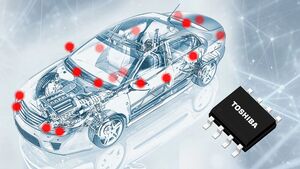
Toshiba to Provide Samples of Clock Extension Peripheral Interface Driver/Receiver IC That Contributes to Wiring Harnesses Reduction
"Toshiba Electronic Devices & Storage Corporation ("Toshiba") will this month start to provide test samples of “TB9032FNG,” an automotive driver/receiver IC for the physical layer interface defined in the Clock Extension Peripheral Interface (CXPI) [1] , the standard for automotive communications protocols. The electrification of automobiles is increasing the number of electronic components in automotive systems, adding to their complexity, and also to vehicle weight, as more wiring harnesses are required. The solution to this issue lies in changing the current system, where a human machine interface (HMI) [2] connects switches and sensors in a one-to-one manner, for a system that uses multiplex transmission in-vehicle communications to reduce wiring harnesses. HMI integrates an area network (CAN) [3] and a local interconnect network (LIN) [4]; the former is costly, the latter lacks responsiveness. CXPI, the in-vehicle communications protocols developed in Japan, and now adopted as an international standard, includes in-vehicle subnetworks that cost less than CAN and that are more responsive than LIN. TB9032FNG combines Motor Driver IC and CXPI communications, and provides as a network interface for in-vehicle body applications, or as an interface for zone electronic control units (ECUs) [5]." [...]
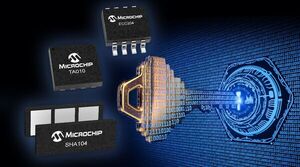
Microchip Expands its Secure Authentication IC Portfolio
"Six new security-focused products aim to optimize and scale embedded security across a wide range of industries including IoT, consumer, industrial and automotive CHANDLER, Ariz., March 14, 2023 – Embedded security continues to be a high priority, and architects need vetted, easy-to-use and cost-optimized security solutions that are compliant with industry best practices. To provide architects with comprehensive embedded security solutions, Microchip Technology (Nasdaq: MCHP) today announces it has expanded its secure authentication device portfolio with six new products in its CryptoAuthentication™ and CryptoAutomotive™ IC families that meet Common Criteria Joint Interpretation Library (JIL) High rated secure key storage and support certified algorithms that comply with the Federal Information Processing Standard (FIPS). This portfolio of secure authentication devices lowers the barrier to entry and enables developers of products for new segments and applications to implement trusted authentication to prevent counterfeiting, improve quality control and safeguard the user experience. As counterfeits become prevalent across many industries, the need to implement embedded trust in many designs is critical. The devices are supported by the Trust Platform Design Suite, a dedicated software tool used to onboard these ICs with Microchip’s secure key provisioning service. The scalable service enables cryptographic assets to be provisioned for projects of virtually any size, ranging from tens of devices to large-scale deployments across a variety of industries such as consumer and medical disposables, automotive and industrial accessory ecosystems, wireless charging and data centers." [...]

NASA Awards Advance 3D Printing, Quantum Tech for Climate Research
"New technology is a key to helping NASA advance its long-term exploration goals for the benefit of all. To support its effort, the agency announced Thursday it will create two new institutes to develop technology in critical areas for engineering and climate research. Two new Space Technology Research Institutes (STRIs) will leverage teams led by U.S. universities to create multidisciplinary research and technology development programs critical to NASA's future. By bringing together science, engineering, and other disciplines from universities, industry, and non-profits, the institutes aim to impact future aerospace capabilities through investments in early-stage technology. One of the research institutes will focus on quantum sensing technology in support of climate research. The other will work to improve understanding and help enable rapid certification of metal parts created using advanced manufacturing techniques." [...]

TI makes embedded systems more affordable with new Arm® Cortex®-M0+ MCU portfolio
"Introducing a new 32-bit general-purpose MCU portfolio for almost any application, with parts starting at an industry-low US$0.39 Texas Instruments (TI) (Nasdaq: TXN) is expanding its broad analog and embedded processing semiconductor portfolio by introducing a scalable Arm® Cortex®-M0+ microcontroller (MCU) portfolio that features a wide range of computing, pinout, memory and integrated analog options. With an initial launch of dozens of MCUs supported by intuitive software and design tools, the MSPM0 MCU portfolio allows designers to spend more time innovating and less time evaluating and coding – cutting design time from months to days. Learn more about streamlining electronic designs with low-cost, easy-to-program Arm Cortex-M0+ MCUs at www.ti.com/mspm0-pr. "TI is building the industry’s most comprehensive portfolio of Arm Cortex-M0+ based MCUs – expanding an already extensive semiconductor offering with options for general-purpose designs," said Vinay Agarwal, vice president, MSP Microcontrollers, Texas Instruments. "Our new MCUs provide the flexibility our customers need to enhance the sensing and control capabilities of their systems while cutting cost, complexity and design time." Find the right processing and integrated analog features for any general-purpose design Designers can select from a wide range of computing options from 32 MHz to 80 MHz with math acceleration and multiple configurations of integrated analog signal-chain components, including the industry’s first zero-drift operational amplifier on an MCU and precision 12-bit, 4-MSPS analog-to-digital converters." [...]
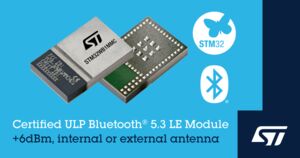
STMicroelectronics simplifies and accelerates wireless product development with certified STM32WB1MMC Bluetooth® LE module
"The new STM32 Bluetooth® wireless module from STMicroelectronics lets designers access the advantages of ST’s dual core STM32WB microcontrollers (MCUs), especially in projects intended for low-to-medium production volumes. The module simplifies development and accelerates time to market, combining Bluetooth Low Energy 5.3 certification and worldwide radio-equipment approvals with the STM32Cube ecosystem support. The all-in-one STM32WB1MMC module alleviates supply-chain headaches and lead-time issues, and helps avoid certification costs and delays. Delivering a full reference design in an LGA package, the STM32WB1MMC assembles the complete bill of materials needed for a functioning wireless product on cost-efficient PCB technology. There is an internal antenna and optimized matching network, as well as convenient pins for attaching an external antenna instead of the internal one if required. RF performance up to +6dBm output power and -96dBm sensitivity, with optimized signal routing, ensures reliable communication over long distances at data rates up to 2Mbit/s." [...]
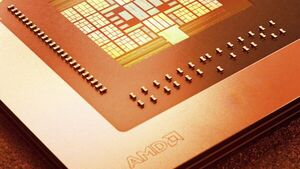
AMD Brings World-Class Performance of 4th Gen AMD EPYC™ Processors to Embedded Networking, Security, Storage and Industrial Systems
"AMD (NASDAQ: AMD) today announced it is bringing world-class performance and energy efficiency to embedded systems with AMD EPYC™ Embedded 9004 Series processors. The new 4th generation EPYC Embedded processors powered by “Zen 4” architecture provide technology and features for embedded networking, security/firewall and storage systems in cloud and enterprise computing as well as industrial edge servers for the factory floor. Built on the “Zen 4” 5nm core, the processors combine speed and performance while helping reduce both overall system energy costs and TCO. The series is comprised of 10 processor models with performance options ranging from 16 to 96 cores, and a thermal design power (TDP) profile ranging from 200W to 400W. The performance and power scalability afforded with AMD EPYC Embedded 9004 Series processors make them an ideal fit for embedded system OEMs expanding their product portfolios across a range of performance and pricing options. The AMD EPYC Embedded 9004 Series processors also include enhanced security features to help minimize threats and maintain a secure compute environment from power-on to run time, making them well suited for applications with enterprise-class performance and security needs." [...]
Newest 8 Megapixel onsemi Image Sensor Achieves Stunning 4K Video Quality
"onsemi’s AR0822 optimizes for the harshest lighting conditions with 120 dB embedded High Dynamic Range (eHDR) and high efficiency near-infrared response, alongside several embedded power-saving features onsemi (Nasdaq: ON), a leader in intelligent power and sensing technologies, today announced the launch of a new, innovative image sensor – the AR0822. The device’s embedded High Dynamic Range (eHDR) feature and optimized near-infrared (NIR) response are necessary for applications with harsh lighting conditions, such as security and surveillance, body cameras, doorbell cameras and robotics. The sensor’s low-power architecture and Wake-on-Motion features are designed to reduce system power significantly. The AR0822 is an 8-megapixel (MP) stacked 1/1.8−inch (8.81mm diagonal) back-side illuminated (BSI) CMOS digital image sensor based upon a 2.0 µm pixel. It features an active−pixel array of 3840 (H) x 2160 (V) and is capable of 4K video at 60 frames-per-second (fps), capturing images in either linear or eHDR modes (120 dB) with a rolling-shutter readout. “The AR0822 delivers industry-leading performance in low-light conditions while enabling our customers to achieve the 120 dB of eHDR they need with lower system power and cost,” said Ross Jatou, senior vice president and general manager, Intelligent Sensing Group, onsemi." [...]

Engineers Keep an Eye on Fuel Supply of NASA’s Oldest Mars Orbiter
"Measuring the fuel supply on Odyssey, a decades-old spacecraft without a fuel gauge, is no easy task. Since NASA launched the 2001 Mars Odyssey Orbiter to the Red Planet almost 22 years ago, the spacecraft has looped around Mars more than 94,000 times. That’s about the equivalent of 1.37 billion miles (2.21 billion kilometers), a distance that has required extremely careful management of the spacecraft’s fuel supply. This feat is all the more impressive given that Odyssey has no fuel gauge; engineers have had to rely on math instead. Their work has helped Odyssey build a scientific legacy: The spacecraft has mapped minerals across the Martian surface, allowing scientists to better understand the planet’s history. Odyssey has found ice deposits that could be used by future astronauts." [...]

Renesas Expands RA MCU Family with Two New Entry-Line Groups Offering Optimal Combination of Performance, Features and Value
"New RA4E2 and RA6E2 MCUs Deliver High Performance up to 200 MHz in Compact Packages with Rich Peripheral Options Renesas Electronics Corporation (TSE:6723), a premier supplier of advanced semiconductor solutions, today announced the expansion of its 32-bit RA family of microcontrollers (MCUs) with two new Groups based on the Arm® Cortex®-M33 core with Arm TrustZone® technology. The new 100-MHz RA4E2 Group and 200-MHz RA6E2 Group are optimized to provide best-in-class power efficiency without compromising performance. With 128 Kbyte and 256 Kbyte flash options and 40 Kbytes of SRAM, the new groups integrate abundant connectivity options such as on-chip CAN FD, USB, QSPI, SSI and I3C interfaces and offer an easy upgrade path to other members of the RA Family. They are ideal for applications requiring high performance in small packages such as sensing, gaming, wearables and appliances. The RA4E2 and the RA6E2 are the most cost-effective members of the RA family with integrated CAN FD, and are available with small package options including a space saving 4 x 4 mm 36-pin BGA and a 5 x 5 mm 32-pin QFN to satisfy the needs of cost-sensitive and space-constrained applications. In addition, the low power consumption of the new devices saves energy, enabling end products to contribute to a greener environment." [...]

NASA’s Webb Telescope Captures Rarely Seen Prelude to Supernova
"A massive star on the cusp of death ejected huge volumes of hot gas into space. Webb’s Mid-Infrared Instrument revealed the structure of the material now surrounding the star. The rare sight of a Wolf-Rayet star – among the most luminous, most massive, and most briefly detectable stars known – was one of the first observations made by NASA’s James Webb Space Telescope in June 2022. Webb shows the star, WR 124, in unprecedented detail with its powerful infrared instruments. The star is 15,000 light-years away in the constellation Sagittarius. Massive stars race through their lifecycles, and only some of them go through a brief Wolf-Rayet phase before going supernova, making Webb’s detailed observations of this rare phase valuable to astronomers." [...]

Efficient and high-performing vehicle architecture: Cooperation of Continental and Infineon
"Continental will be collaborating with Infineon Technologies AG in the development of server-based vehicle architectures. The goal is an organized and efficient electrics/electronics (E/E) architecture with central high-performance computers (HPC) and a few, powerful Zone Control Units (ZCU) instead of up to a hundred or even more individual control units, as it was previously the case. Continental now uses Infineon's AURIX TC4 microcontroller for its ZCU platform. Thanks to special storage technology in the AURIX TC4, the vehicle software is on standby. As soon as the vehicle is started, functions such as parking assistance, air conditioning, heating and suspension are ready within fractions of a second. With its platform approach, Continental is supporting the different requirements of the automobile manufacturers." [...]

TI unlocks scalable edge AI performance in smart camera applications with new vision processor family
"Designers can easily and affordably add vision and AI processing for up to 12 cameras in building, industrial and retail automation applications To build on innovations that advance intelligence at the edge, Texas Instruments (TI) (Nasdaq: TXN) today introduced a new family of six Arm® Cortex®-based vision processors that allow designers to add more vision and artificial intelligence (AI) processing at a lower cost, and with better energy efficiency, in applications such as video doorbells, machine vision and autonomous mobile robots. This new family, which includes the AM62A, AM68A and AM69A processors, is supported by open-source evaluation and model development tools, and common software that is programmable through industry-standard application programming interfaces (APIs), frameworks and models. This platform of vision processors, software and tools helps designers easily develop and scale edge AI designs across multiple systems while accelerating time to market. For more information, see www.ti.com/edgeai-pr. "In order to achieve real-time responsiveness in the electronics that keep our world moving, decision-making needs to happen locally and with better power efficiency," said Sameer Wasson, vice president, Processors, Texas Instruments. "This new processor family of affordable, highly integrated SoCs will enable the future of embedded AI by allowing for more cameras and vision processing in edge applications."" [...]

STMicroelectronics provides full STM32 support for Microsoft Visual Studio Code
"STMicroelectronics (NYSE: STM), a global semiconductor leader serving customers across the spectrum of electronics applications, has announced tool extensions that bring the advantages of Microsoft® Visual Studio Code (VS Code) to STM32 microcontrollers. VS Code is a popular Integrated Development Environment (IDE), acclaimed for its ease of use and flexible features such as IntelliSense that simplifies and accelerates code editing. Access to the STM32 ecosystem, from within VS Code, now makes these features available to even more embedded developers of the wide STM32 community. It also lets developers accustomed to working on high-level and consumer applications easily create embedded solutions that are power-efficient, compact, and economical. “Connecting VS Code with our STM32 ecosystem makes the power of the industry-leading STM32 family of microcontrollers more accessible than ever,” said Daniel Colonna, Marketing Director Microcontrollers, STMicroelectronics. “Communities for whom VS Code is the preferred environment, including high-level software developers, academics, and enthusiasts and makers, can now choose to make their ideas real using STM32 MCUs without leaving their preferred development environment.” “Through our deep collaboration with STMicroelectronics we have been able to provide capabilities that allow STM32 projects to be used in Visual Studio Code,” said Marc Goodner, Principal Product Manager, Microsoft." [...]
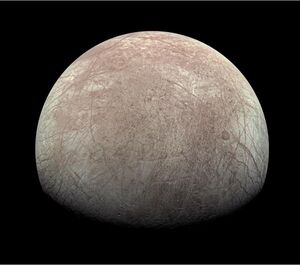
Study Finds Ocean Currents May Affect Rotation of Europa’s Icy Crust
"Research reveals a new explanation for how the icy shell of Jupiter’s moon Europa rotates at a different rate than its interior. NASA’s Europa Clipper will take a closer look. NASA scientists have strong evidence that Jupiter’s moon Europa has an internal ocean under its icy outer shell – an enormous body of salty water swirling around the moon’s rocky interior. New computer modeling suggests the water may actually be pushing the ice shell along, possibly speeding up and slowing down the rotation of the moon’s icy shell over time. Scientists have known that Europa’s shell is probably free-floating, rotating at a different rate than the ocean below and the rocky interior. The new modeling is the first to show that Europa’s ocean currents could be contributing to the rotation of its icy shell." [...]

Increasing access to education for people with disabilities
"Around the world 2.2 billion people have a form of vision disability according to WHO. As disabilities affect people of all ages, it’s critical that education is accessible to all and ensures equitable access to children and adults alike. However, the reality is there are currently barriers in education for those who are blind or have low vision, including the lack of accessible textbooks and classroom materials. This is what is commonly referred to as a “book famine” in the print disabled community. Founded initially as self-advocacy group for people who are blind or low vision with an interest in STEM, I-Stem aims to enhance access to this otherwise inaccessible content for people with print disabilities. Through their past experience having experienced the challenges first-hand as blind co-founders, coupled with their experience in engineering and AI, the team uses AI to address this barrier faced by their community." [...]
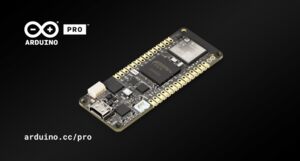
Portenta C33: The high-performance, low-price oxymoron
"While democratizing professional solutions may seem like an oxymoron, that’s exactly what Arduino Pro is out to achieve. Our business-oriented unit stands at industrial clients’ side with a growing ecosystem of high-performance, reliable, secure products that aim to provide the right solution for every need big and small companies may have, in any field and at any stage of their growth. Case in point: the Portenta C33. The module – which we are introducing at Embedded World 2023 – leverages the R&D carried out for previous Portenta modules, optimizing every aspect and streamlining features to offer a cost-effective option to users starting out with Industrial IoT or automation, or those who have more specific, targeted needs than the H7 or X8 cater to. Is the Portenta C33 right for you? Check out its main tech specs: - Arm® Cortex®-M33 microcontroller by Renesas - MicroPython and other high-level programming languages are supported - Onboard Wi-Fi® and Bluetooth® Low Energy connectivity - Secure element for industrial-grade security at the hardware level - Secure OTA firmware updates (connecting to Arduino IoT Cloud or third-party services) - Compatible with Portenta, MKR, and Nicla components - Castellated pins - Wide variety of peripheral interfaces, including CAN, SAI, SPI, and I2C What’s more, the Portenta C33 is born into an extensive ecosystem that comes not only with a variety of components that easily combine, but also with ready-to-use software libraries and Arduino sketches shared and perfected by our incredible community." [...]
Ciência e Tecnologia

High-performance detectors to combat spies
"A team from UNIGE and ID Quantique has developed single-photon detectors with unprecedented performance. These results open new perspectives for quantum cryptography. How can we combat data theft, which is a real issue for society? Quantum physics has the solution. Its theories make it possible to encode information (a qubit) in single particles of light (a photon) and to circulate them in an optical fibre in a highly secure way. However, the widespread use of this telecommunications technology is hampered in particular by the performance of the single-photon detectors." [...]
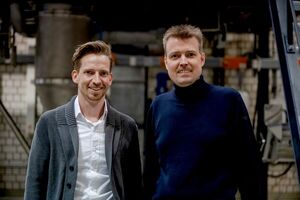
Making metal 3D printing more efficient
"The potential for energy and material savings offered by additive manufacturing compared to conventional processes is enormous. But the devil is in the details. Metal components can not only be designed more flexibly using 3D printing. So-called additive manufacturing also saves material and energy compared to conventional manufacturing processes such as casting of a melt. The aim of the REACT project, short for “Resource Efficient Additive manufacturing of martensitic Cr-sTeels”, is to fully exploit these savings potentials. The project, led by Professor Sebastian Weber, holder of the Chair of Materials Technology at Ruhr University Bochum, Germany, will start with a kick-off event for all six partners on 14 March 2023." [...]

Building an understanding of quantum turbulence from the ground up
"Researchers show how energy disappears in quantum turbulence. The discovery paves way for a better understanding of turbulence in scales ranging from the microscopic to the planetary. Most people only encounter turbulence as an unpleasant feature of air travel, but it’s also a notoriously complex problem for physicists and engineers. The same forces that rattle planes are swirling in a glass of water and even in the whorl of subatomic particles. Because turbulence involves interactions across a range of distances and timescales, the process is too complicated to be solved through calculation or computational modelling – there’s simply too much information involved. Scientists have attempted to tackle the issue by studying the turbulence that occurs in superfluids, which is formed by tiny identical whirls called quantized vortices." [...]

STAR Physicists Track Sequential 'Melting' of Upsilons
"Findings provide evidence for 'deconfinement' and insight into seething temperature of the hottest matter on Earth Scientists using the Relativistic Heavy Ion Collider (RHIC) to study some of the hottest matter ever created in a laboratory have published their first data showing how three distinct variations of particles called upsilons sequentially “melt,” or dissociate, in the hot goo. The results, just published in Physical Review Letters, come from RHIC’s STAR detector, one of two large particle tracking experiments at this U.S. Department of Energy (DOE) Office of Science user facility for nuclear physics research. The data on upsilons add further evidence that the quarks and gluons that make up the hot matter—which is known as a quark-gluon plasma (QGP)—are “deconfined,” or free from their ordinary existence locked inside other particles such as protons and neutrons. The findings will help scientists learn about the properties of the QGP, including its temperature. “By measuring the level of upsilon suppression or dissociation we can infer the properties of the QGP,” said Rongrong Ma, a physicist at DOE’s Brookhaven National Laboratory, where RHIC is located, and Physics Analysis Coordinator for the STAR collaboration. “We can’t tell exactly what the average temperature of the QGP is based solely on this measurement, but this measurement is an important piece of a bigger picture." [...]

Phosphorus sets the pace in high-performance transistors
"Ultrathin phosphorus semiconductors that become metallic when stacked can tackle resistance issues and boost transistor performance. A newly discovered blue form of ultrathin phosphorus — with electronic properties that can be tuned to enhance the injection of charge carriers (negatively and positively charged) into transistors — are set to push next-generation electronic devices forward. Two-dimensional semiconductors, such as graphene and transition metal dichalcogenides, are expected to drive the miniaturization of electronic devices by providing ultrathin active channels for charge-carrier transport in field effect transistors (FETs). Essential to modern circuitry, FETs are used to influence the flow of current through their channels by applied voltage and behave like electronically controlled switches or amplifiers. However, electric resistance arises at the interfaces between the semiconductor channels and metal electrodes. This limits the charge injection into the devices and prevents the FETs from reaching their full potential." [...]

Minimizing electric vehicles’ impact on the grid
"Careful planning of charging station placement could lessen or eliminate the need for new power plants, a new study shows. National and global plans to combat climate change include increasing the electrification of vehicles and the percentage of electricity generated from renewable sources. But some projections show that these trends might require costly new power plants to meet peak loads in the evening when cars are plugged in after the workday. What’s more, overproduction of power from solar farms during the daytime can waste valuable electricity-generation capacity. In a new study, MIT researchers have found that it’s possible to mitigate or eliminate both these problems without the need for advanced technological systems of connected devices and real-time communications, which could add to costs and energy consumption. Instead, encouraging the placing of charging stations for electric vehicles (EVs) in strategic ways, rather than letting them spring up anywhere, and setting up systems to initiate car charging at delayed times could potentially make all the difference." [...]
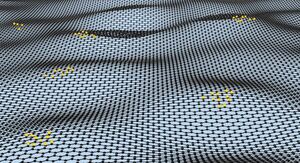
Nanorippled graphene becomes a catalyst
"A team of researchers led by Prof. Andre Geim from the National Graphene Institute (NGI) have discovered that nanoripples in graphene can make it a strong catalyst, contrary to general expectations that the carbon sheet is as chemically inert as the bulk graphite from which it is obtained. Published this week in the Proceedings of the National Academy of Sciences (PNAS), the research has shown that graphene with nanoscale corrugations of its surface can accelerate hydrogen splitting as well as the best metallic-based catalysts. This unexpected effect is likely to be present in all two-dimensional materials, which are all inherently non-flat. The Manchester team in collaboration with researchers from China and USA conducted a series of experiments to show that non-flatness of graphene makes it a strong catalyst. First, using ultrasensitive gas flow measurements and Raman spectroscopy, they demonstrated that graphene’s nanoscale corrugations were linked to its chemical reactivity with molecular hydrogen (H2) and that the activation energy for its dissociation into atomic hydrogen (H) was relatively small. The team evaluated whether this reactivity is enough to make the material an efficient catalyst." [...]

3D-printed revolving devices can sense how they are moving
"A new system enables makers to incorporate sensors into gears and other rotational mechanisms with just one pass in a 3D printer. Integrating sensors into rotational mechanisms could make it possible for engineers to build smart hinges that know when a door has been opened, or gears inside a motor that tell a mechanic how fast they are rotating. MIT engineers have now developed a way to easily integrate sensors into these types of mechanisms, with 3D printing. Even though advances in 3D printing enable rapid fabrication of rotational mechanisms, integrating sensors into the designs is still notoriously difficult. Due to the complexity of the rotating parts, sensors are typically embedded manually, after the device has already been produced. However, manually integrating sensors is no easy task." [...]
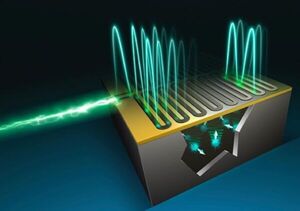
Quantum engineers have designed a new tool to probe nature with extreme sensitivity
"This new spin measuring device could help scientists - particularly in chemistry and biology - understand the structure and purpose of materials better. In a paper published over the weekend in the journal Science Advances, Associate Professor Jarryd Pla and his team from UNSW School of Electrical Engineering and Telecommunications, together with colleague Scientia Professor Andrea Morello, described a new device that can measure the spins in materials with high precision. “The spin of an electron – whether it points up or down – is a fundamental property of nature,” says A/Prof. Pla. “It is used in magnetic hard disks to store information, MRI machines use the spins of water molecules to create images of the inside of our bodies, and spins are even being used to build quantum computers. “Being able to detect the spins inside materials is therefore important for a whole range of applications, particularly in chemistry and biology where it can be used to understand the structure and purpose of materials, allowing us to design better chemicals, drugs and so on.” In fields of research such as chemistry, biology, physics and medicine, the tool that is used to measure spins is called a spin resonance spectrometer." [...]
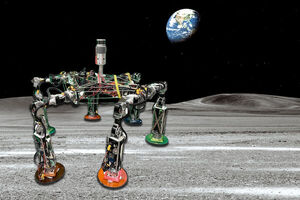
Mix-and-match kit could enable astronauts to build a menagerie of lunar exploration bots
"Robotic parts could be assembled into nimble spider bots for exploring lava tubes or heavy-duty elephant bots for transporting solar panels. When astronauts begin to build a permanent base on the moon, as NASA plans to do in the coming years, they’ll need help. Robots could potentially do the heavy lifting by laying cables, deploying solar panels, erecting communications towers, and building habitats. But if each robot is designed for a specific action or task, a moon base could become overrun by a zoo of machines, each with its own unique parts and protocols. To avoid a bottleneck of bots, a team of MIT engineers is designing a kit of universal robotic parts that an astronaut could easily mix and match to rapidly configure different robot “species” to fit various missions on the moon. Once a mission is completed, a robot can be disassembled and its parts used to configure a new robot to meet a different task." [...]

UC physicist explores mysteries of strange metals
"Physicists at the University of Cincinnati are learning more about the bizarre behavior of “strange metals,” which operate outside the normal rules of electricity. Theoretical physicist Yashar Komijani, an assistant professor in UC’s College of Arts and Sciences, contributed to an international experiment using a strange metal made from an alloy of ytterbium, a rare earth metal. Physicists in a lab in Hyogo, Japan, fired radioactive gamma rays at the strange metal to observe its unusual electrical behavior. Led by Hisao Kobayashi with the University of Hyogo and RIKEN, the study was published in the journal Science. The experiment revealed unusual fluctuations in the strange metal’s electrical charge. “The idea is that in a metal, you have a sea of electrons moving in the background on a lattice of ions,” Komijani said." [...]

Engineering breakthrough in softbotics
"Carnegie Mellon University engineers have developed a soft material with metal-like conductivity and self-healing properties that is the first to maintain enough electrical adhesion to support digital electronics and motors. This advance, published in Nature Electronics, marks a breakthrough in softbotics and the fields of robotics, electronics, and medicine. At Carnegie Mellon University, softbotics represents a new generation of soft machines and robots manufactured by multi-functional materials that have integrated sensing, actuation, and intelligence. The research team introduced the material, a liquid-metal filled organogel composite with high electrical conductivity, low stiffness, high stretchability, and self-healing properties in three applications: - damage-resistant snail-inspired robot - modular circuit to power a toy car - reconfigurable bioelectrode to measure muscle activity on different locations of the body "This is the first soft material that can maintain a high-enough electrical conductivity to support digital electronics and power-hungry devices," said lead author Carmel Majidi, Professor of Mechanical Engineering. "We have demonstrated you can actually power motors with it." The fully untethered snail robot used the self-healing conductive material on its soft exterior, which was embedded with a battery and electric motor to control motion." [...]
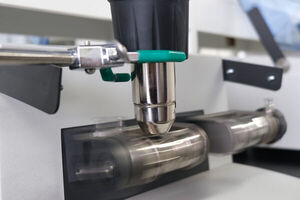
Customizing catalysts for solid-state reactions
"The first-ever molecular catalyst specifically tailored for mechanochemical reaction conditions enables high-efficiency transformations at near room temperature. Chemists at Hokkaido University and the Institute for Chemical Reaction Design and Discovery (WPI-ICReDD) have developed the first high-performance catalyst specifically designed and optimized for solid-state, mechanochemical synthesis. The team found that by attaching long polymer molecules to a metal catalyst, they could trap the catalyst in a fluid-phase, which enabled efficient reactivity at near room temperature. This approach, reported in the Journal of the American Chemical Society, could bring cost and energy savings if adapted for wide application in chemical research and industry. Chemical synthetic reactions are usually performed in solution, where dissolved molecules can intermingle and react freely. In recent years, however, chemists have developed a process called mechanochemical synthesis, in which solid state crystals and powders are ground together." [...]
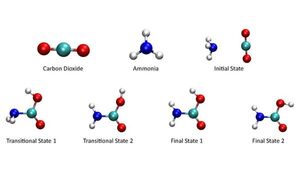
Cleaning Up the Atmosphere with Quantum Computing
"A quantum computing algorithm could identify better compounds for more efficient carbon capture. The amount of carbon dioxide in the atmosphere increases daily with no sign of stopping or slowing. Too much of civilization depends on the burning of fossil fuels, and even if we can develop a replacement energy source, much of the damage has already been done. Without removal, the carbon dioxide already in the atmosphere will continue to wreak havoc for centuries. Atmospheric carbon capture is a potential remedy to this problem. It would pull carbon dioxide out of the air and store it permanently to reverse the effects of climate change." [...]
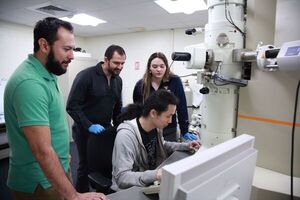
WVU lab’s game-changing high-performance semiconductor material could help slash heat emissions
"Researchers at West Virginia University have engineered a material with the potential to dramatically cut the amount of heat power plants release into the atmosphere. A team led by Xueyan Song, professor and George B. Berry Chair of Engineering at the Benjamin M. Statler College of Engineering and Mineral Resources, has created an oxide ceramic material that solves a longstanding efficiency problem plaguing thermoelectric generators. Those devices can generate electricity from heat, including power plant heat emissions, which contribute to global warming. The breakthrough oxide ceramic Song's team produced "achieved a record-high performance that had been deemed impossible," she said. "We demonstrated the best thermoelectric oxide ceramics reported in the field worldwide over the past 20 years, and the results open up new research directions that could further increase performance." Cesar Octavio Romo de la Cruz, Yun Chen, Liang Liang and Sergio A. Paredes Navia contributed to the study, supported by $639,784 in National Science Foundation funding." [...]
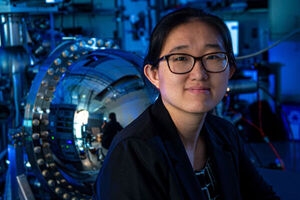
Magnetism fosters unusual electronic order in quantum material
"Experiments reveal link between intertwined states in ‘kagome’ metal Physicists were surprised by the 2022 discovery that electrons in magnetic iron-germanium crystals could spontaneously and collectively organize their charges into a pattern featuring a standing wave. Magnetism also arises from the collective self-organization of electron spins into ordered patterns, and those patterns rarely coexist with the patterns that produce the standing wave of electrons physicists call a charge density wave. In a study published this week in Nature Physics, Rice University physicists Ming Yi and Pengcheng Dai, and many of their collaborators from the 2022 study, present an array of experimental evidence that shows their charge density wave discovery was rarer still, a case where the magnetic and electronic orders don’t simply coexist but are directly linked. “We found magnetism subtly modifies the landscape of electron energy states in the material in a way that both promotes and prepares for the formation of the charge density wave,” said Yi, a co-corresponding author of the study. The study was co-authored by more than a dozen researchers from Rice; Oak Ridge National Laboratory (ORNL); SLAC National Accelerator Laboratory; Lawrence Berkeley National Laboratory (LBNL); the University of Washington; the University of California, Berkeley; Israel’s Weizmann Institute of Science; and China’s Southern University of Science and Technology. The iron-germanium materials are kagome lattice crystals, a much-studied family of materials featuring 2D arrangements of atoms reminiscent of the weave pattern in traditional Japanese kagome baskets, which features equilateral triangles that touch at the corners." [...]
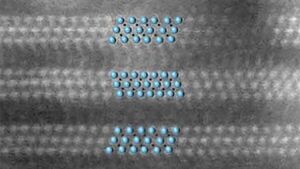
Nano Cut-and-Sew: New Method for Chemically Tailoring Layered Nanomaterials Could Open Pathways to Designing 2D Materials on Demand
"A new process that lets scientists chemically cut apart and stitch together nanoscopic layers of two-dimensional materials — like a tailor altering a suit — could be just the tool for designing the technology of a sustainable energy future. Researchers from Drexel University, China and Sweden, have developed a method for structurally splitting, editing and reconstituting layered materials, called MAX phases and MXenes, with the potential of producing new materials with very unusual compositions and exceptional properties. A “chemical scissor” is a chemical designed to react with a specific compound to break a chemical bond. The original set of chemical scissors, designed to break carbon-hydrogen bonds in organic molecules, was reported more than a decade ago. In a paper recently published in Science, the international team reported on a method to sharpen the scissors so that they can cut through extremely strong and stable layered nanomaterials in a way that breaks atomic bonds within a single atomic plane, then substitutes new elements — fundamentally altering the material’s composition in a single chemical “snip.” “This research opens a new era of materials science, enabling atomistic engineering of two-dimensional and layered materials,” said Yury Gogotsi, PhD, Distinguished University professor and Bach chair in Drexel’s College of Engineering, who was an author of the research. “We are showing a way to assemble and disassemble these materials like LEGO blocks, which will lead to the development of exciting new materials that have not even been predicted to be able to exist until now.” Gogotsi and his collaborators at Drexel have been studying the properties of a family of layered nanomaterials called MXenes, that they discovered in 2011." [...]
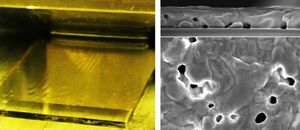
Perovskite solar cells from the slot die coater - a step towards industrial production
"Solar cells made from metal halide perovskites achieve high efficiencies and their production from liquid inks requires only a small amount of energy. A team led by Prof. Dr. Eva Unger at Helmholtz-Zentrum Berlin is investigating the production process. At the X-ray source BESSY II, the group has analyzed the optimal composition of precursor inks for the production of high-quality FAPbI3 perovskite thin films by slot-die coating. The solar cells produced with these inks were tested under real life conditions in the field for a year and scaled up to mini-module size. Metal halide perovskites are considered to be a particularly low-cost and promising class of materials for next-generation solar modules. Perovskite solar cells can be produced with coating processes using liquid inks made from precursor materials and various solvents." [...]
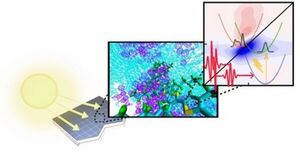
Modelling superfast processes in organic solar cell material
"In organic solar cells, carbon-based polymers convert light into charges that are passed to an acceptor. This type of material has great potential, but to unlock this, a better understanding is needed of the way in which charges are produced and transported along the polymers. Scientists from the University of Groningen have now calculated how this happens by combining molecular dynamics simulations with quantum calculations and have provided theoretical insights to interpret experimental data. The results were published on 15 March in the Journal of Physical Chemistry C. Organic solar cells are thinner than classic silicon-based cells and they are flexible and probably easier to manufacture. To improve their efficiency, it is important to understand how charges travel through the polymer film. 'These films are made up of an electron donor and an electron acceptor,' explains Elisa Palacino-González, a postdoctoral researcher in the Theory of Condensed Matter group at the Zernike Institute for Advanced Materials, University of Groningen (the Netherlands)." [...]
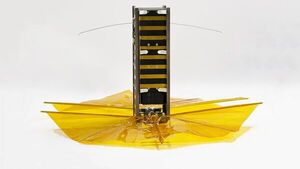
Satellite built by Brown students and launched by SpaceX shows a low-cost way to reduce space junk
"Common sense suggests that space missions can only happen with multimillion-dollar budgets, materials built to withstand the unforgiving conditions beyond Earth's atmosphere, and as a result of work done by highly trained specialists. But a team of engineering students from Brown University has turned that assumption on its head. They built a satellite on a shoestring budget and using off-the-shelf supplies available at most hardware stores. They even sent the satellite—which is powered by 48 Energizer AA batteries and a $20 microprocessor popular with robot hobbyists—into space about 10 months ago, hitching a ride on Elon Musk's SpaceX rocket. Now, a new analysis of data from Air Force Space Command shows that the satellite not only successfully operated, but could have far-ranging impacts on efforts to cut down on the growing problem of space debris, which poses a potential danger to all current and future space vehicles. According to NASA, there are now more than 27,000 pieces of what it calls orbital debris or space junk being tracked by the Department of Defense's global Space Surveillance Network." [...]
Projetos Maker
Diversos Projetos interessantes.
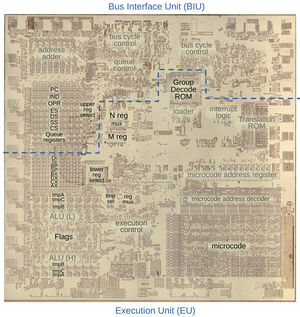
Reverse-engineering the register codes for the 8086 processor's microcode
"Like most processors, the Intel 8086 (1978) provides registers that are faster than main memory. As well as the registers that are visible to the programmer, the 8086 has a handful of internal registers that are hidden from the user. Internally, the 8086 has a complicated scheme to select which register to use, with a combination of microcode and hardware. Registers are assigned a 5-bit identifying number, either from the machine instruction or from the microcode. In this blog post, I explain how this register system works. My analysis is based on reverse-engineering the 8086 from die photos." [...]

A "Nixie Tube" Style Desk Clock
"I wanted to replicate the design of those cool looking "Nixie Tube" clocks but with a freeform circuit style that I enjoy making, so I decided to make this. Overall I think this idea can be taken further and a lot of others things could be built with this style of 7 segment led display (I have a lot of ideas in my mind, just need some time to make them). This design does require a fair bit of soldering work and does take some time and patiences to complete, but the end result is definitely worth it. Supplies Now the supplies are very important to ensure that you get the correct results when producing the freeform circuits. The specific supplies used in the projects are provided below, with relevant links: Materials - Brass Wire (0.8mm) - SMD LEDs (1206) - SMD Resistor (1206) - TPIC6C596 (SOIC 16) - Arduino Nano - DS3231 Mini - 5 Pin Female Header - M2 Inserts - M2 Bolts - 2.1mm Power Connector - Glass Tubes - Electrical Wires - 5V Power Supply - Wood or Filament (For CNC or 3D printing) - Freeform 7Seg PCB - Paper / 3D Printed Templates Tools - Wire Cutters - Pliers - Tweezers - Soldering Iron - Solder Wire - Flux Pen - Double Sided Tape - Soldering Silicone Mat - 3D printer - CNC machine - (only required if you want to machine the wooden base)" [...]

FeedomBox
"Inspiration design for Passover Jewish holiday. Overview "Truly, God our Lord, that You delivered us from Egypt and liberated us from the place of enslavement" (Jewish prayer book) Every day, religious Jews recite a prayer to commemorate the miraculous event of the Exodus. This verse is also a prominent part of a well-known melody sung during the Passover Jewish holiday. Drawing inspiration from this tradition, I created a "Freedom Box", designed to recharge and refresh individuals when they feel stressed and cornered. Simply press the red button and rejuvenate! The pentagon shape is adorned with vector drawings purchased from ShutterStock, all of which are related to Passover holiday traditions." [...]
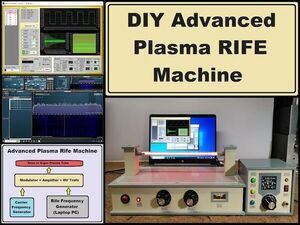
DIY Advanced Plasma Rife Machine
"This deviceis in every respect superior to the original Plasma Rife machine, mainly thanks to today's level of development of Electronics. Royal Raymond Rife was a scientist, inventor and medical researcher (1888-1971). He is known for his microscopes, which he claimed could observe live microorganisms but also by an electronic device constructed by him called the Rife Machine, which according to his claims, is capable of curing very serious and incurable diseases. In order not to repeat myself, if you are interested in the method of operation, making, technical characteristics, the way it is claimed to heal and many other information regarding the Rife machine, I recommend you to watch my previous video related to this topic. There you can also read my personal opinion regarding the technical functionality, but also the claims in medical terms, at least as far as I can conclude. Also, I described a very simple way how to make such a machine yourself if you have basic knowledge in the field of electronics." [...]
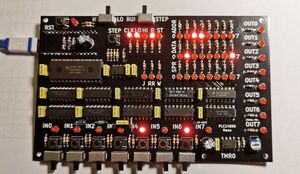
PLC14500 Nano
"The PLC14500 Nano is a retro-style trainer board intended for the user to familiarize with the Motorola MC14500 1-bit ICU (Industrial Control Unit), PLCs and Ladder Logic. The board has abundant LEDs that show the status of the system buses and registers. This, combined with the possibility to run the software step by step, gives the user a great deal of insight into how their programs are executing. The slow clock mode makes instead for a mesmerizing light show that won't fail to impress when the board is parked on a desk, waiting for the next coding adventure. Main features: - 256 Bytes of program RAM (can be replaced with an EEPROM) - 7 Inputs each with toggle and momentary switch capability - 7 Outputs - 1 Timer mapped to the I/O bus (0.5 to 30s, adjustable via a trimmer) - 8 bits scratchpad RAM - 3 clock modes (fast, slow, manual step) True to its retro style PLC14500 Nano sports exclusively through-hole components and chips in DIP packages. You might notice an intruder in the Bill of Materials, an Arduino Nano!" [...]

Washing Up Liquid dispenser
"Do you hate doing the dishes? Do you wish there was a way to make this chore less tedious and more fun? Do you have a spare Raspberry Pi Pico lying around and some basic electronics skills? If you answered yes to any of these questions, then this project is for you! In this post, I will show you how to make a washing up liquid dispenser that automatically squirts soap onto your sponge when you bring it close. No more picking up the bottle and squeezing it every time you need more soap." [...]
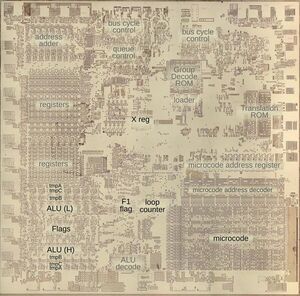
Reverse-engineering the multiplication algorithm in the Intel 8086 processor
"While programmers today take multiplication for granted, most microprocessors in the 1970s could only add and subtract — multiplication required a slow and tedious loop implemented in assembly code.1 One of the nice features of the Intel 8086 processor (1978) was that it provided machine instructions for multiplication,2 able to multiply 8-bit or 16-bit numbers with a single instruction. Internally, the 8086 still performed a loop, but the loop was implemented in microcode: faster and transparent to the programmer. Even so, multiplication was a slow operation, about 24 to 30 times slower than addition. In this blog post, I explain the multiplication process inside the 8086, analyze the microcode that it used, and discuss the hardware circuitry that helped it out.3 My analysis is based on reverse-engineering the 8086 from die photos. The die photo below shows the chip under a microscope. I've labeled the key functional blocks; the ones that are important to this post are darker." [...]
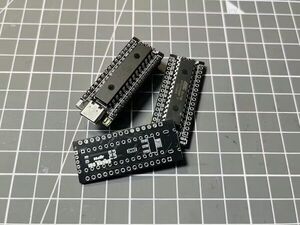
My minimal Arduino Nano board
"I made this development board to use in prototypes which I want for a long time. This will save me a lot of money and equal compatibility. Sometimes I must prototype my projects to kept them working for a long time. And most of the work is Around Arduino specially atmega328p microcontroller. It is an 8-bit microcontroller which can work up to 20Mhz frequency. On the Arduino hub there are a lot of sensor interfacing tutorial and free sketches you can access and repeat the projects." [...]

RP2040 based Pi-Day Bling
"RP2040-based bling that changes its LED color when it detects one of three keywords: "Pi", "3.14", or "Irrational" Happy Pi-Day! This project describes a bling designed around the RP2040 microcontroller. In the spirit of celebrating Pi-Day, it is designed to capable of detecting three words namely: Pi, 3.14, and Irrational. When it detects one of these keywords, the RGB LEDs on the bling change their color. Components The bling is designed around the RP2040 microcontroller. The following image shows the components of the bling." [...]
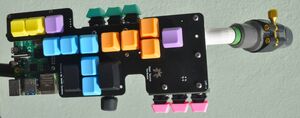
Haxophone
"A haxophone is an electronic musical instrument that resembles a saxophone. It is designed to be an inexpensive and fully customizable travel saxophone. You will never get the same expressiveness or depth of sound of a real saxophone. But with a haxophone you should be able to play alone or with friends wherever you might be. The mechanical keys and unique ergonomics give it a different kind of satisfying feel. The design is fully open, software and hardware." [...]
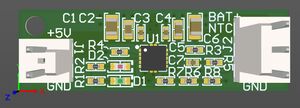
Battery-Charger
"Li-Ion battery charger, based on BQ24060 IC, this simple PCB takes 5V as input and charges a 3.7V Li-Ion battery. The charger has output short circuit protection and optional thermal protection. It can charge a battery with current up to 1A (the charging current is set by a resistor), the PCB works without a problem at charging current up to ~0.7A, at higher current without heatsink or cooling the IC heats up and enters thermal protection, cycling the charging on and off. " [...]

Everyday Work Safety
"I have designed a safety system for remote controls that immediately turns off the vehicle when the operator puts down the remote control Introduction My experience in the field of mobile robotics put me in front of different critical situations in which a correct use of a remote control device for the driving of a robot would have avoided some accidents. Fortunately I have not lived extreme situations, but I have understood the importance of safety in the workplace. All employees have the right to work in a safe environment, in which all health and safety risks are managed to prevent dangerous and harmful situations. Safety of workers should be considered a priority for the employers, not only because unsafe workplaces, injuries and work-related diseases can have serious legal and financial consequences and can damage the company's image and reputation, but also because the employers have a moral obligation towards workers: it’s a duty and moral responsibility of the company to keep employees safe and healthy in the workplace. Of course, we are all aware that total safety does not exist “even by staying in your bed at home”, but precautions must be taken to safeguard the life of the workers and ensure a work environment as much as possible without dangers. Employers have primary duty to ensure all health and safety requirements are met, however, all employees also play a crucial role in this: everyone is responsible for himself and others in the workplace; health and safety in the workplace is everyone’s responsibility." [...]

mouseVRheadset
"The mouseVRheadset is a VR system for mouse neuroscience and behavior research. By positioning the headset to the eyes of a head-fixed mouse running on a treadmill, virtual scenes can be displayed to the mouse in both closed-loop (treadmill motion controls the visual scene) and open-loop (visual scenes unaffected by movement) modes. The headset is powered by a Raspberry Pi 4, Godot video game engine, and a custom display driver for controlling each eye's display. A 3D printed case holds the Raspberry Pi and display eyepieces -- each eyepiece containing a circular display and Fresnel lens to cover a wide field-of-view (~70 deg solid angle) of the mouse eye and put the visual scene at a focal length of [approximately] infinity. The heart of the mouseVRheadset is a Raspberry Pi 4 running the Godot video game engine. Since the displays are relatively low resolution (240x210), an inexpensive single-board computer like a Raspberry Pi 4 is all that's needed to effectively render visual scenes at high (>60 fps) framerates." [...]

slow-movie-frame-10.3
"The scope/goal of this project was to create a picture frame enclosing an e-paper device which plays movies in a very slow manner. This project was inspired by Tom Whitwell's Very Slow Movie Player which I have read about on Hackaday. Ever since, I wanted to create my own. So, eventually, I did. To achieve the goal, a Waveshare 10.3 inch 16 gray scale color e-paper device and a Raspberry Pi Zero 2 W with Raspberry Pi OS for operating system were chosen. While the software can be modified to run on different hardware and operating systems, doing so is out of the scope of this project." [...]
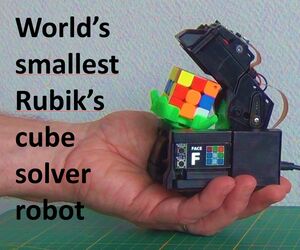
DIY the World's Smallest Rubik's Cube Solver Robot
"This is CUBOTtino Micro, the smallest Rubik's cube robot solver in the World, and it can be made at home. The dimensions are ca 7cm x 9cm x 9cm (WxDxH). Main characteristics of Cubotino micro are: - The robot is fully autonomous. - It works with the 30mm Rubik's cube keychain (GAN 330). - PiCamera and Raspberry Pi Zero2W (or ZeroW) for the computer vision part. - Kociemba solver, to get an almost optimal solution." [...]

8 LED POV Using Arduino Nano
"Hi All, I helped my son to make the 8 LED POV for his school project. In doing so I was able to introduce him to SolderingTesting electronic componentsArduino codingThis is a beginner's level project.. that one can start with or introduce, to your kids. Please try it and share your feedback and comments Supplies: - Universal PCB - Arduino Nano or clone - Green 5 mm LEDs - 8 - 100 OHm registers - 8 - Copper wire for jumpers - 9V battery holder with switch - 9V battery - Female header pins - Wooden stick - Double side tape - Multimeter - Solder iron - Paper tape" [...]
Secção Videos
Videos interessantes.
That's all Folks!



